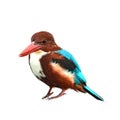Designed by
Title
Throated kingfisher on hand #287795905
Description
Kingfishers are distributed worldwide except in the polar regions, high altitudes, and remote islands. They are concentrated in Southeast Asia, New Guinea and tropical Africa. There are 90 species of kingfishers in the world. They belong to the family Alcedinidae which is divided into three subfamilies.The Kingfishers, unlike certain other species of birds, show an unmistakeable general similarity. They have strong, straight and pointed beaks, which are long, enabling them to catch fish easily. They have compact bodies, short necks and large heads.Their legs are rather short and their toes are syndactyl. This means that they have three toes in front of their foot and one at the back. In some cases the second toe is much reduced or totally absent as in the Three-toed Kingfisher.The wings are short and rounded and the tails vary in length. Kingfishers are all brightly coloured birds that are strikingly beautiful. The two sexes are generally alike. Kingfishers have large eyes and good eye sight which enables them to see fish in the water below.Kingfishers are sit-and-wait predators, scanning a wide area from a favorite perch. If there is no suitable perch, they may hover over the water. Solitary birds are seen and also pairs but rarely in groups.Kingfishers dig their nests in earth banks along rivers or in the coastal areas. Their nests have also been found in mounds of earth, anthills and even, on occasion, in a hole in a tree.The pair build the nest together. For those that dig holes, the male starts off by flying at the surface and stabbing at it with his bill until he has created a grip from which he can start digging. The male and female then take turns to dig the tunnel.These nests have a long, upward entrance hole at the end of which is the nest chamber. The nest chamber dips down at the end of the tunnel so that the young in the nest cannot roll out.Depending on the species two to six pure white eggs are laid. Since they nest in holes and there is no need to camouflage the eggs. In fact, the white eggs are better seen in the dark recesses of the nest hole. The female usually incubates in the initial stages, but the male eventually takes over.The young are naked and ugly but soon take on the bright colours of their species. Towards the end just before the young leave, the nest and the nest chamber take on a very foul smell.

















